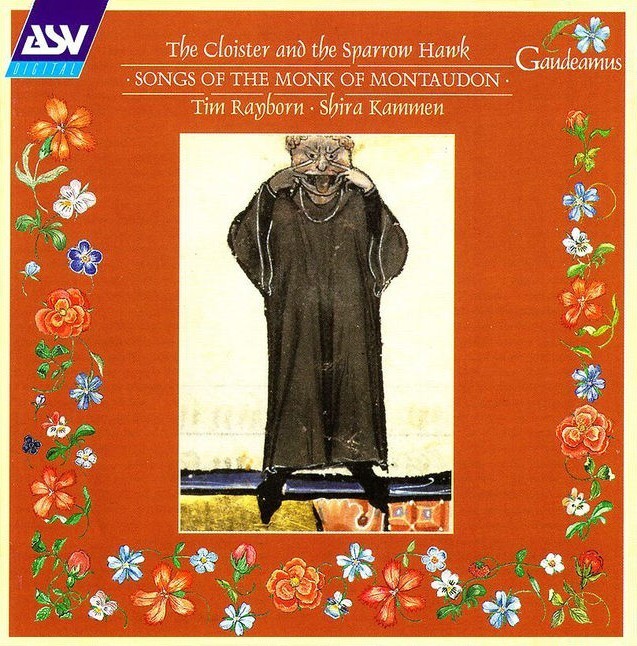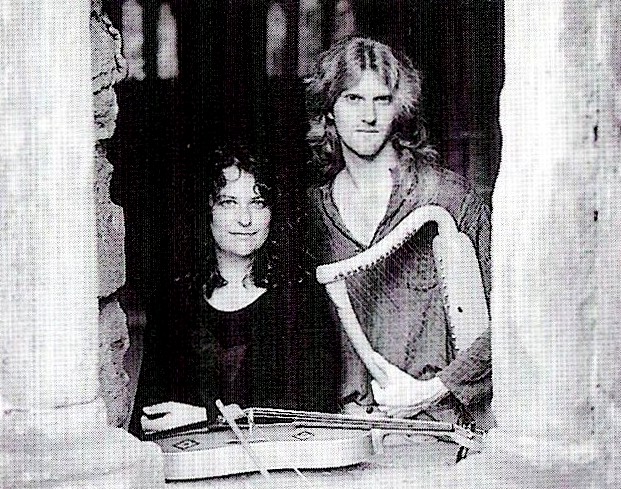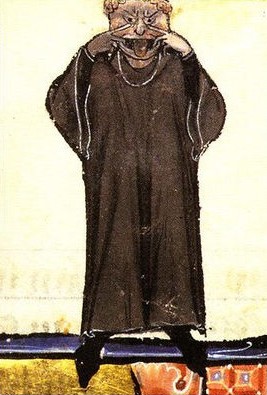The Cloister and the Sparrow Hawk / Tim Rayborn · Shira Kammen
Songs of the Monk of Montaudon

medieval.org
AS&V Gaudeamus 175
1998
1. Estampie 'Cor irat' [3:40]
instrumental on 'Be m'enueia', arr. Kammen |
ShK, vielle · TR, percussion
2. Be m'enueia, so auzes dire? [7:40]
“I find annoying, do you hear me?” |
TR, voice · ShK, vielle
3. Two motets on 'Era pot' [1:54]
instrumental, arr. Kammen |
ShK, rebec · TR, harp
4. Era pot ma domna saber [7:59]
“Now my lady may know” |
TR, voice · ShK, harp
5. Dansa 'Era pot' [3:09]
instrumental, arr. Kammen |
ShK, vielle · TR, ‘ud
6. Lengua d'argen [2:19]
instrumental on 'Quan tuit', arr. Kammen |
ShK, vielle
7. Quan tuit aquist clam foron fat [7:59]
“When all these complaints have been made” |
cf. Peire VIDAL. Nulhs hom no·s
TR, voice · ShK, vielle · Alison Sabedoria, voice, bell
8. Dansa 'Folhs motz' [1:48]
instrumental on 'Quan tuit', arr. Kammen |
ShK, vielle · TR, percussión
9. Amicx Robert, fe que dey vos [3:34]
“Robert, my friend, I promise you” |
cf. Daude de PRADAS (attr.). Bele m'es la veis |
TR, voice
10. Belha messios [6:13]
instrumental and estampie on 'Amicx Robert', arr. Rayborn |
TR, harp
11. Pos Peire d'Alvernh'a cantat [13:44]
“Since Peire d'Alvernha has sung” |
cf. Guillem ADEMAR. Lai can vei florir
TR, voice, percussion · ShK, vielle

Tim Rayborn · voice, harp, ‘ud, percussion
Shira Kammen · vielle, rebec, harp
with
Alison Sabedoria, voice, bell
TIM RAYBORN
Tim Rayborn, originally from Northern California,
is the founder of Ensemble Florata. He has been devoted to the study and
performance of medieval music and the traditional music of the Middle
East for nearly a decade. He has performed throughout Britain and
Europe, including concerts at both the York and Beverley Early Music
Festivals, and the Jersey International Festival, as well as with
traditional musicians in Marrakesh and Istanbul.
SHIRA KAMMEN
Shira
Kammen is based in the San Francisco Bay Area, where she received her
music degree from U.C. Berkeley, and was for many years a member of both
Ensemble Alcatraz and Ensemble Project Ars Nova. She studied vielle and
medieval music with Margriet Tindemans, and also has worked with the
Boston Camerata, Sequentia, Hesperion XX and The King's Noyse. She has
performed, recorded and taught medieval and traditional music
extensively in the USA, Europe and North Africa.
Instruments
Vielle — Fabrizio Reginato, Fonte Alto, Italy, 1984
Vielle — Karl Dennis, Warren, Rhode Island, USA, 1993
Rebec — John Fleagle, Boston, Massachusetts, USA, 1985
Harp — 'Blondel', Tim Hobrough, Strathpeffer, Scotland, 1994
‘Ud — Samir Hamida, Cairo, Egypt
Drum — traditional wooden frame drum
Musical arrangements by Shira Kammen and Tim Rayborn
Contrafacts by Tim Rayborn:
· Quan tuit aquist — adapted by Rayborn from Nulhs horn no·s by Peire Vidal
· Amicx Robert — contrafacted from Bele m'es la veis, ascribed to Daude de Pradas
· Pos Peire d'Alvernh'a — contrafected from Lai can vey florir by Guillem Ademar
Produced by Tim Raybom, Shim Kammen and Colin Potter
Recorded by Colin Potter, IC Studios, 19-21 August, 1997
Translations
of texts by Dr Michael Routledge, Royal Holloway University, London,
and grateful acknowledgments for his assistance and input
Thanks
to Sarah Zandona for her help and initial working translations of the texts
and special thanks to Alison Sabedoria for her invaluable vocal
coaching and contributions
Original recording concept by Shira Kammen
℗ & © 1998

The
Monk of Montaudon stands as a singularly curious and often amusing
figure in the history of troubadour poetry and song. His true name is
unknown, but he flourished in the late twelfth century, and apparently
came from a noble family in the Auvergne region. He suffered the fate
which often befell the younger male children of such families, being
offered to a monastery, in this case the Abbey of Orlac. At some point,
he became Prior of Montaudon, thus acquiring the title by which we now
know him.
However, this man was no ordinary monk, and despite his
enforced devotion to the monastic vocation (or perhaps because of it)
he showed a remarkable talent for vernacular poetry and music, writing
verses in a number of the standard poetic forms employed by the
troubadours of the time. The language was Occitan, a Romance language
resembling Catalan. It was widely-spoken in medieval southern France,
and used to exquisite literary effect by the troubadours.
The
Monk's work attracted the attentions and patronage of the nobility. He
was regularly invited to leave behind the cloister and participate in
their many feasts and tournaments, performing his works and engaging in
the popular poetic and musical contests of the time. The fact that he
dutifully donated the rewards won from these events to the monastery
treasury was no doubt a major factor in his being allowed to continue
this connection with the secular world.
Indeed, at the Court of
Puy Sainte Marie, famous for its troubadour contests, he was made master
of revels. This honour entitled him to open the annual feast with a
ceremony in which he held on his arm a sparrow-hawk, which would then be
accepted by the baron who had chosen to sponsor the event, a sometimes
ruinous expense. The Monk continued such secular connections throughout
his life. He is known to have been active in Spain as well, being
affiliated with the monastery of Villafranca. King Alfonso of Aragón was
among his patrons.
His work differs in some respects from that
of his contemporaries, no doubt due in part to the very different life
which he lived. Many of his poems have a keen wit and biting sarcasm,
quite humorous, even vulgar, but verging at times on the cruel. It is as
if he is holding up the entire genre to ridicule, whilst still making
fine use of the poetic forms.
Chief among these is the Enueg, or
'annoyance' song, wherein the poet describes, in a humorous, random and
seemingly nonsensical manner, various things which he finds irritating.
We include two examples here [tracks 2, 9]. It is very possible that
these works provide tantalising glimpses into the Monk's own life, in
which case, he was far from pious!
The longest piece on this recording is a Sirventes, Pos Peire.
Here the Monk's invective is in fine form, as he takes an impish glee
in mercilessly insulting and demeaning his musical contemporaries,
before finally turning his venom on himself.
Quan tuit recounts a curious debate in heaven between religious icons and ladies over the right to use facial paint. Era pot
is a more typical courtly love lyric, and is the only non-satirical
piece on this recording. It was probably composed according to courtly
conventions rather than expressing any true feelings. However, given
that the Monk's entrance into the monastic life was probably unwilling,
ant that he had continual contact with various courts throughout his
life, we will probably never be certain of his amorous intentions.
Only two of the Monk's pieces have survived with music, Be m'enueia and Era pot. Be m'eneuia, shares its melody with a piece by Bertan de Born, Rassa, tan derts. The question, therefore, as to which of these two wrote music the music is open to speculation.
In
order that these wonderful poems can live again musically for the
modern listener, we have created contrafacts, that is, taken existing
melodies from the Monk's contemporaries and set his words to their
music. Thin was it wide-spread practice throughout the Middle Ages, with
new poems often being set by their authors to popular songs of the day.
Instrumental
music abounded in the Middle Ages, commonly being created based on
vocal models, and we have provided examples here of this practice. Such
pieces would have been played to enhance the performance of troubadour
songs, and could have involved a number of different instruments. We
have provided titles for them taken from the Monk's poetry.
Concerning
performance practice, it appears that often troubadour poems were sung
unaccompanied or with a single instrument, the favourite of which was
the vielle (the medieval fiddle). The harp also seems likely for such
music, though the evidence for the use of instruments with the various
types of troubadour songs is rather confusing and inconclusive. We
believe that medieval musical practices were varied enough in different
regions and times to allow for both types of performance, and we reflect
this on the recording. The texts are interpreted theatrically,
reflecting their amusing and even ridiculous content. These songs were
obviously meant for the listeners' amusement and so invite a variety of
vocal colours and effects.
It is hoped that the music of this
unusual man will entertain the modem listener, with both the cleverness
of its literary content and the richness of its melodies. The Monk of
Montaudon lived in two very different worlds, with one foot in each. His
unique position allowed him to offer his own critique of his life as a
troubadour, and at the same time not scandalise his religious vocation.
His amusing bits of monastic nose-thumbing make a refreshing change
indeed!
Tim Rayborn, 1998


